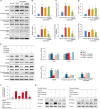Targeting Extracellular Heat Shock Protein 70 Ameliorates Doxorubicin-Induced Heart Failure Through Resolution of Toll-Like Receptor 2-Mediated Myocardial Inflammation
- PMID: 31576776
- PMCID: PMC6818050
- DOI: 10.1161/JAHA.119.012338
Targeting Extracellular Heat Shock Protein 70 Ameliorates Doxorubicin-Induced Heart Failure Through Resolution of Toll-Like Receptor 2-Mediated Myocardial Inflammation
Abstract
Background Heart failure (HF) is one of the most significant causes of morbidity and mortality for the cardiovascular risk population. We found previously that extracellular HSP70 (heat shock protein) is an important trigger in cardiac hypertrophy and fibrosis, which are associated with the development of heart dysfunction. However, the potential role of HSP70 in response to HF and whether it could be a target for the therapy of HF remain unknown. Methods and Results An HF mouse model was generated by a single IP injection of doxorubicin at a dose of 15 mg/kg. Ten days later, these mice were treated with an HSP70 neutralizing antibody for 5 times. We observed that doxorubicin treatment increased circulating HSP70 and expression of HSP70 in myocardium and promoted its extracellular release in the heart. Blocking extracellular HSP70 activity by its antibody significantly ameliorated doxorubicin-induced left ventricular dilation and dysfunction, which was accompanied by a significant inhibition of cardiac fibrosis. The cardioprotective effect of the anti-HSP70 antibody was largely attributed to its ability to promote the resolution of myocardial inflammation, as evidenced by its suppression of the toll-like receptor 2-associated signaling cascade and modulation of the intracellular distribution of the p50 and p65 subunits of nuclear factor-κB. Conclusions Extracellular HSP70 serves as a noninfectious inflammatory factor in the development of HF, and blocking extracellular HSP70 activity may provide potential therapeutic benefits for the treatment of HF.
Keywords: cardiac dysfunction; cardiac remodeling; damage‐associated molecular patterns; nuclear factor‐κB; toll‐like receptor.
Figures





Similar articles
-
Toll-like receptor-2 mediates adaptive cardiac hypertrophy in response to pressure overload through interleukin-1β upregulation via nuclear factor κB activation.J Am Heart Assoc. 2013 Nov 18;2(6):e000267. doi: 10.1161/JAHA.113.000267. J Am Heart Assoc. 2013. PMID: 24249711 Free PMC article.
-
Atorvastatin Improves Doxorubicin-Induced Cardiac Dysfunction by Modulating Hsp70, Akt, and MAPK Signaling Pathways.J Cardiovasc Pharmacol. 2019 Apr;73(4):223-231. doi: 10.1097/FJC.0000000000000646. J Cardiovasc Pharmacol. 2019. PMID: 30540688
-
Hsp70 regulates the doxorubicin-mediated heart failure in Hsp70-transgenic mice.Cell Stress Chaperones. 2014 Nov;19(6):853-64. doi: 10.1007/s12192-014-0509-4. Epub 2014 Apr 20. Cell Stress Chaperones. 2014. PMID: 24748476 Free PMC article.
-
Hsp70 and cardiac surgery: molecular chaperone and inflammatory regulator with compartmentalized effects.Cell Stress Chaperones. 2009 Mar;14(2):117-31. doi: 10.1007/s12192-008-0066-9. Epub 2008 Jul 31. Cell Stress Chaperones. 2009. PMID: 18668350 Free PMC article. Review.
-
HSP70 and Primary Arterial Hypertension.Biomolecules. 2023 Feb 1;13(2):272. doi: 10.3390/biom13020272. Biomolecules. 2023. PMID: 36830641 Free PMC article. Review.
Cited by
-
Traditional Chinese Medicine Targeting Heat Shock Proteins as Therapeutic Strategy for Heart Failure.Front Pharmacol. 2022 Jan 18;12:814243. doi: 10.3389/fphar.2021.814243. eCollection 2021. Front Pharmacol. 2022. PMID: 35115946 Free PMC article. Review.
-
Overexpression of Heat Shock Protein 70 Improves Cardiac Remodeling and Survival in Protein Phosphatase 2A-Expressing Transgenic Mice with Chronic Heart Failure.Cells. 2021 Nov 15;10(11):3180. doi: 10.3390/cells10113180. Cells. 2021. PMID: 34831402 Free PMC article.
-
Blocking Extracellular Chaperones to Improve Cardiac Regeneration.Front Bioeng Biotechnol. 2020 May 26;8:411. doi: 10.3389/fbioe.2020.00411. eCollection 2020. Front Bioeng Biotechnol. 2020. PMID: 32528937 Free PMC article.
-
Zymosan A Improved Doxorubicin-Induced Ventricular Remodeling by Evoking Heightened Cardiac Inflammatory Responses and Healing in Mice.J Am Heart Assoc. 2023 Sep 19;12(18):e030200. doi: 10.1161/JAHA.123.030200. Epub 2023 Sep 13. J Am Heart Assoc. 2023. PMID: 37702058 Free PMC article.
-
Dissecting the interaction between HSP70 and vascular contraction: role of [Formula: see text] handling mechanisms.Sci Rep. 2021 Jan 14;11(1):1420. doi: 10.1038/s41598-021-80966-6. Sci Rep. 2021. PMID: 33446873 Free PMC article.
References
-
- Braunwald E. The war against heart failure: the Lancet lecture. Lancet. 2015;385:812–824. - PubMed
-
- Mebazaa A, Yilmaz MB, Levy P, Ponikowski P, Peacock WF, Laribi S, Ristic AD, Lambrinou E, Masip J, Riley JP, McDonagh T, Mueller C, deFilippi C, Harjola VP, Thiele H, Piepoli MF, Metra M, Maggioni A, McMurray JJ, Dickstein K, Damman K, Seferovic PM, Ruschitzka F, Leite‐Moreira AF, Bellou A, Anker SD, Filippatos G. Recommendations on pre‐hospital and early hospital management of acute heart failure: a consensus paper from the Heart Failure Association of the European Society of Cardiology, the European Society of Emergency Medicine and the Society of Academic Emergency Medicine–short version. Eur Heart J. 2015;36:1958–1966. - PubMed
-
- Zhang Y, Bauersachs J, Langer HF. Immune mechanisms in heart failure. Eur J Heart Fail. 2017;19:1379–1389. - PubMed
Publication types
MeSH terms
Substances
LinkOut - more resources
Full Text Sources
Medical
Research Materials
Miscellaneous

